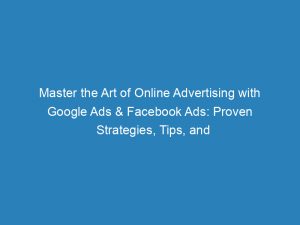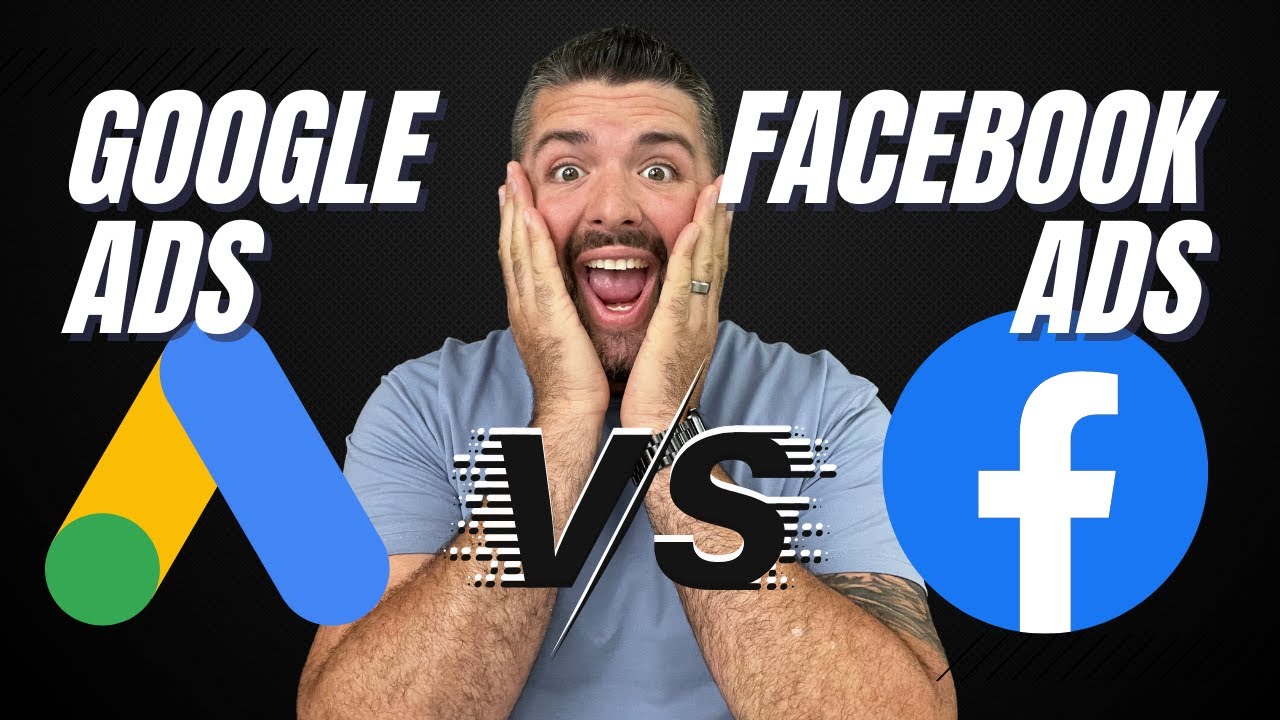In the ever-evolving world of digital advertising, two giants rule the domain: GoogleAds and FacebookAds. These platforms have revolutionized the way businesses connect with their target audience, propelling revenue and brand recognition to new heights.
But what sets them apart? Google Ads, known for capturing demand with its vast search network, allows businesses to showcase their products or services to users actively searching for them.
On the flip side, FacebookAds takes a different approach, focusing on building brand awareness and reaching prospects who may not yet be aware of their needs. Both platforms bring unique advantages to the table, but the real magic happens when they’re combined.
Join us as we uncover the secrets to leveraging the power of Google Ads and Facebook Ads together for maximum ROI and explosive business growth.
Table of Contents
- google ads facebook ads
- Platform Differences: Google Ads Vs Facebook Ads
- Google Ads: Capturing Demand And Targeting High Purchase Intent
- Facebook Ads: Boosting Brand And Product Awareness
- Consider Goals And Budget When Choosing Between Platforms
- Granular Targeting And High Clickthrough Rate With Facebook Ads
- Strong ROI And Clickthrough Rate Improvement With Google Ads
- Benefits Of Using Both Google Ads And Facebook Ads
- Targeting Keywords And Text-Based Ads With Google Ads
- Targeting Demographics And Interests With Facebook Ads
google ads facebook ads
The main difference between Google Ads and Facebook Ads lies in the platforms on which they operate. Google Ads is primarily used for demand capture, targeting users with high purchase intent.
On the other hand, Facebook Ads is better suited for increasing brand and product awareness. When deciding between the two platforms, it is crucial to consider campaign goals and budget.
Facebook Ads offers granular targeting capabilities and a high clickthrough rate, while Google Ads boasts a strong return on investment and features to improve clickthrough rates. Utilizing both platforms in a complementary manner can be highly beneficial for businesses.
Google Ads focuses on targeting keywords and using text-based ads, while Facebook Ads allows businesses to target specific demographics and interests. Google Ads has a larger potential audience that rewards relevance and ad quality, whereas Facebook Ads offers a high return on investment at an affordable cost.
By ensuring consistent marketing messaging across both platforms, businesses can achieve maximum ROI and overall growth.Key Points:
- Google Ads is used for demand capture and targeting high purchase intent users.
- Facebook Ads is better for increasing brand and product awareness.
- Campaign goals and budget should be considered when choosing between the two platforms.
- Facebook Ads has granular targeting capabilities and a high clickthrough rate.
- Google Ads has a strong return on investment and features to improve clickthrough rates.
- Utilizing both platforms in a complementary manner can be highly beneficial for businesses.
Sources
https://blog.hubspot.com/marketing/facebook-ads-vs-google-ads
https://www.wordstream.com/facebook-vs-google
https://databox.com/facebook-ads-or-google-ads
https://www.facebook.com/business/help/715308018651375
Check this out:
? Pro Tips:
1. Utilize Facebook Ads for retargeting purposes: Take advantage of Facebook’s granular targeting capabilities to reach users who have already shown interest in your products or website. This can help increase conversions and improve overall campaign performance.
2. Optimize your Google Ads with ad extensions: Enhance your text-based ads on Google by utilizing ad extensions such as sitelinks, call extensions, and location extensions. These additional features can improve clickthrough rates and provide more relevant information to potential customers.
3. Leverage the power of lookalike audiences on Facebook: Expand your reach on Facebook by creating lookalike audiences based on your existing customer base. Facebook’s algorithm will find users who share similar characteristics and behaviors, increasing the chances of attracting new customers to your business.
4. Use Google Ads‘ remarketing campaigns strategically: Implement remarketing campaigns on Google Ads to re-engage users who have previously visited your website but didn’t convert. This can help remind them of your offerings and encourage them to make a purchase or take another desired action.
5. A/B test ad creatives and targeting options on both platforms: Continuously experiment with different ad creatives and targeting options on both Google Ads and Facebook Ads to optimize your campaigns. By testing multiple variations, you can identify what resonates best with your audience and improve overall campaign performance.
Platform Differences: Google Ads Vs Facebook Ads
When it comes to online advertising, two of the biggest players in the game are Google Ads and Facebook Ads. Although both platforms offer effective ways to reach potential customers, they have different strengths and audiences.
Understanding these differences is crucial in order to maximize the potential of your advertising campaigns.
Google Ads is primarily focused on demand capture, targeting users who are actively searching for products or services related to your business. When a user conducts a search on Google using specific keywords, Google Ads displays relevant ads at the top of the search results page.
This allows businesses to connect with users who are already motivated to make a purchase. On the other hand, Facebook Ads is more geared towards brand and product awareness.
With Facebook’s massive user base, businesses can target specific demographics and interests, making it an ideal platform for increasing brand visibility and reaching a wider audience.
Google Ads: Capturing Demand And Targeting High Purchase Intent
One of the main advantages of Google Ads is its ability to target users who have a high purchase intent. By displaying ads to users who are actively searching for specific products or services, businesses can connect with potential customers at the perfect moment.
This makes Google Ads an excellent option for businesses looking to capture immediate demand and generate quick conversions. Additionally, Google Ads allows businesses to target specific keywords and create text-based ads, giving them full control over their messaging and targeting strategy.
Facebook Ads: Boosting Brand And Product Awareness
On the other hand, Facebook Ads excels in boosting brand and product awareness. With its sophisticated targeting capabilities, businesses can reach specific demographics and interests, ensuring their ads are shown to the most relevant audience.
This targeted approach allows businesses to create a buzz around their brand and pique the interest of potential customers who may not have been actively searching for their products or services. With a high clickthrough rate and the ability to generate engagement, Facebook Ads can help businesses build brand recognition and expand their customer base.
Consider Goals And Budget When Choosing Between Platforms
When deciding between Google Ads and Facebook Ads, it’s important to consider your campaign goals and budget. If you’re looking to capture demand and target users with high purchase intent, Google Ads may be the better choice.
On the other hand, if your main objective is to raise awareness and reach a wider audience, Facebook Ads might be the way to go. It’s also worth noting that Google Ads generally has a larger potential audience, while Facebook Ads offers a more affordable option with a high return on investment.
Ultimately, it’s about finding the right balance between your campaign goals, target audience, and available budget.
Granular Targeting And High Clickthrough Rate With Facebook Ads
One of the standout features of Facebook Ads is its granular targeting capabilities. Businesses can choose specific demographics, interests, and behaviors to ensure their ads are shown to the most relevant audience.
This level of targeting allows businesses to create highly personalized and tailored campaigns, increasing the likelihood of engagement and conversions. additionally, Facebook Ads boasts a high clickthrough rate, meaning users are more likely to click on your ad and take action.
This combination of precise targeting and high clickthrough rate makes Facebook Ads a powerful tool for businesses looking to drive results.
Strong ROI And Clickthrough Rate Improvement With Google Ads
While Facebook Ads focuses on brand awareness, Google Ads is known for its strong return on investment (ROI) and the ability to improve clickthrough rates. With Google ads, businesses can target specific keywords and create text-based ads that appear at the top of relevant search results.
This targeting allows businesses to connect with users who are already actively searching for their products or services. Additionally, Google Ads offers features such as ad extensions and ad optimization tools that can help improve clickthrough rates and increase the effectiveness of your campaigns.
With a well-crafted Google Ads strategy, businesses can see a significant boost in their ROI.
Benefits Of Using Both Google Ads And Facebook Ads
While Google Ads and Facebook Ads have their own strengths, using both platforms in a complementary way can provide businesses with a comprehensive and effective advertising strategy. By leveraging the targeting capabilities of Facebook Ads to build brand awareness and reach a wider audience, businesses can then use Google Ads to capture demand and drive conversions.
This combination allows businesses to cover all stages of the customer journey and maximize their reach and impact. By utilizing consistent marketing messaging across both platforms, businesses can create a cohesive brand experience and achieve maximum ROI and business growth.
Targeting Keywords And Text-Based Ads With Google Ads
One of the key features of Google Ads is its ability to target specific keywords and create text-based ads. Businesses can choose relevant keywords to target and create ads that appear at the top of search results pages.
This enables businesses to connect with users who are actively searching for their products or services, making it an excellent option for capturing demand and driving conversions. By carefully selecting keywords and crafting compelling ad copy, businesses can increase their visibility and attract highly motivated customers.
Fresh look at global CPC and CPM benchmarks.
Targeting Demographics And Interests With Facebook Ads
In contrast to Google Ads, Facebook Ads allows businesses to target specific demographics and interests. With Facebook’s vast user base and detailed user data, businesses can narrow down their audience based on factors such as age, location, interests, and behaviors.
This level of targeting ensures that ads are shown to users who are most likely to be interested in the products or services being advertised. By tailoring ads to specific demographics and interests, businesses can increase engagement, generate brand awareness, and ultimately drive conversions.
Programmatic Advertising • Performance Marketing Tips • Advertising Platform for Marketers • Native Ad Network












